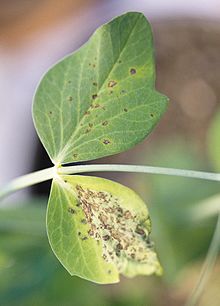디디멜라 핀셋
Didymella pinodes| 디디멜라 핀셋 | |
|---|---|
 | |
| 현장 완두콩의 디디멜라 피노드에 의해 야기된 괴사성 병변은 감염 후 2주 후에 남는다. | |
| 과학적 분류 | |
| 킹덤: | 곰팡이 |
| 구분: | 아스코미코타 |
| 클래스: | 도티데오균류 |
| 순서: | 늑골목 |
| 패밀리: | 디디멜라과 |
| 속: | 디디멜라 |
| 종: | D. 피노드 |
| 이항식 이름 | |
| 디디멜라 핀셋 (Berk. & A. Bloxam) 페트르, (1924년) | |
| 동의어 | |
| |
디디멜라 피노드(동기화). 미코인세렐라 피노데스)는 혈전성 곰팡이 식물 병원체로서 완두콩 식물에 생긴 아스코키타 블레이트의 원인 물질이다. Lathyrus sativus, Lupinus albus, Medicago spp, Trifolium spp, Vicia sativa, Vicia arctulata 등 여러 종에 감염되어 있어 광범위한 병원체로 정의된다.[3]
증상
증상은 나뭇잎의 병변, 줄기, 식물의 꼬투리를 포함한다. 이 병은 두 병원체 중에서 D. 피노드가 더 공격적이긴 하지만 아스코치타 피시에 의한 병상과 구별하기 어렵다.[4]
역학
그 질병의 주기는 발아 피크니디아가 빠르게 발달한 후 아스코스피어의 보급에서 시작된다.[5] 빗방울에 의해 빠르게 흩어지는 피치니디아스포레스는 단거리에서 재감염의 원인이 된다. 결과적으로, 가성종의 생산은 노년기 조직에서 시작된다. 비가 온 후, 아스포스는 가성체에서 방출되고 먼 거리에 바람으로 흩어진다.[6]
질병관리
유용한 저항 수준은 아직 결정되어야 하며 살균 스프레이의 적용은 비경제적이라고 보고되었다.[7][8] 더욱이 스트로빌루론 같은 화학물질에 대한 불감증이 지속적으로 발생한다는 보고도 있었다.[9] 따라서 문화관리는 농작물 잔류물과 토양에 대한 접종 생존뿐만 아니라 접종 이행을 최소화하고, 심방 접종으로부터 초기 감염을 피함으로써 질병 진행상황을 통제하기 위한 사전 선택사항이다.[10] 게다가, 감염된 잔여물을 묻으면 병원균 생존이 감소하지만,[11] 농작물 순환과 경작제도는 질병의 심각성에 거의 영향을 미치지 않는다.[12] 파종 시기를 3~4주 늦출 경우 아스코키타 병충해 심각도가 50%[13] 이상 감소하지만, 재배 기간이 짧아 고위도에서는 이러한 조치가 가능하지 않다.
호스트 저항
지금까지는 완충균에서 불완전한 저항만 가능하며 양적 차이는 식물의 환경조건, 식물연령, 생리학적 특성에 의해 큰 영향을 받는다.[14][15] 발기성장이 더 많은 키 큰 품종은 낮은 D.피노드 감염을 겪는다.[16] 민감성은 귀와 식물의 성숙과 함께 증가한다.[18]
형태학적 특성 외에도, 단백질과 신진대사 연구는 저항에 기여하는 분자 표지를 정확히 찾아냈다.[19] 잎의 질병 심각도는 또한 콩 식물이 소위 유도된 전신 저항성을 유발하는 것으로 추정되는 진드기 박테리아와 연관되었을 때 더 낮은 것으로 보고되었다.[20]
참고 항목
참조
- ^ Chen; et al. (2015). "Resolving the Phoma enigma". Studies in Mycology. 82: 137–217. doi:10.1016/j.simyco.2015.10.003. PMC 4774273. PMID 26955202.
- ^ Clulow, S. A.; Lewis, B. G.; Parker, Mary L.; Matthews, P. (1991-07-01). "Infection of pea epicotyls by Mycosphaerella pinodes". Mycological Research. 95 (7): 817–820. doi:10.1016/S0953-7562(09)80044-0.
- ^ Barilli, Eleonora; Cobos, Maria José; Rubiales, Diego (2016-01-01). "Clarification on Host Range of Didymella pinodes the Causal Agent of Pea Ascochyta Blight". Frontiers in Plant Science. 7: 592. doi:10.3389/fpls.2016.00592. PMC 4865514. PMID 27242812.
- ^ pea ascohyta blight 증상 웨이백머신에 2008-06-08 보관
- ^ Tivoli, B.; Beasse, C.; Lemarchand, E.; Masson, E. (1996-10-01). "Effect of ascochyta blight (Mycosphaerella pinodes) on yield components of single pea (Pisum sativum) plants under field conditions". Annals of Applied Biology. 129 (2): 207–216. doi:10.1111/j.1744-7348.1996.tb05745.x. ISSN 1744-7348.
- ^ Tivoli, Bernard; Banniza, Sabine (2007-03-27). "Comparison of the epidemiology of ascochyta blights on grain legumes". European Journal of Plant Pathology. 119 (1): 59–76. doi:10.1007/s10658-007-9117-9. ISSN 0929-1873. S2CID 38947539.
- ^ Khan, T. N.; Timmerman-Vaughan, G. M.; Rubiales, D.; Warkentin, T. D.; Siddique, K. H. M.; Erskine, W.; Barbetti, M. J. (2013-07-01). "Didymella pinodes and its management in field pea: Challenges and opportunities". Field Crops Research. 148: 61–77. doi:10.1016/j.fcr.2013.04.003. hdl:10261/87380.
- ^ Bretag, TW; Keane, PJ; Price, TV (1995-07-01). "Effect of Ascochyta blight on the grain yield of field peas (Pisum sativum L.) grown in southern Australia". Animal Production Science. 35 (4): 531. doi:10.1071/EA9950531. ISSN 1836-5787.
- ^ Bowness, Robyne; Gossen, Bruce D.; Chang, Kan-Fa; Goswani, Rubella; Willenborg, Christian J.; Holtz, Michael; Strelkov, Stephen E. (2015-07-21). "Sensitivity of Mycosphaerella pinodes to Pyraclostrobin Fungicide". Plant Disease. 100 (1): 192–199. doi:10.1094/PDIS-03-15-0350-RE. ISSN 0191-2917. PMID 30688575.
- ^ McDonald, G. K.; Peck, D. (2009-03-15). "Effects of crop rotation, residue retention and sowing time on the incidence and survival of ascochyta blight and its effect on grain yield of field peas (Pisum sativum L.)". Field Crops Research. 111 (1–2): 11–21. doi:10.1016/j.fcr.2008.10.001.
- ^ Sheridan, J. J. (1973-10-01). "The survival of Mycosphaerella pinodes on pea haulm buried in soil". Annals of Applied Biology. 75 (2): 195–203. doi:10.1111/j.1744-7348.1973.tb07299.x. ISSN 1744-7348.
- ^ Bailey, K. L.; Gossen, B. D.; Derksen, D. A.; Watson, P. R. (2000). "Impact of agronomic practices and environment on diseases of wheat and lentil in southeastern Saskatchewan". Canadian Journal of Plant Science. 80 (4): 917–927. doi:10.4141/p00-007.
- ^ Salam, Moin U.; MacLeod, William J.; Maling, Tim; Prichard, Ian; Seymour, Mark; Barbetti, Martin J. (2011-03-23). "A meta-analysis of severity and yield loss from ascochyta blight on field pea in Western Australia". Australasian Plant Pathology. 40 (6): 591–600. doi:10.1007/s13313-011-0034-1. ISSN 0815-3191. S2CID 23735358.
- ^ Wroth, Janet M. (1999). "Evidence suggests that Mycosphaerella pinodes infection of Pisum sativum is inherited as a quantitative trait". Euphytica. 107 (3): 193–204. doi:10.1023/A:1003688430893. ISSN 0014-2336. S2CID 20590523.
- ^ Fondevilla, S.; Satovic, Z.; Rubiales, D.; Moreno, M. T.; Torres, A. M. (2007-12-13). "Mapping of quantitative trait loci for resistance to Mycosphaerella pinodes in Pisum sativum subsp. syriacum". Molecular Breeding. 21 (4): 439–454. doi:10.1007/s11032-007-9144-4. ISSN 1380-3743. S2CID 23302498.
- ^ Boros, Lech; Marcinkowska, Joanna (2010-08-19). "Assessment of Selected Pea Genotypes Reaction to Ascochyta Blight under Field Conditions and the Impact of Disease Severity on Yield Components". Journal of Agricultural Science. 2 (3): 84. doi:10.5539/jas.v2n3p84. ISSN 1916-9760.
- ^ Bretag, T.W. (2001). Compendium of Pea Diseases and Pests; Foliar diseases caused by fungi. Minnesota. pp. 24–28.
- ^ Hagedorn, D.J. (1991). Handbook of pea Diseases. Minnesota. pp. 11–15.
- ^ Turetschek, Reinhard; Desalegn, Getinet; Epple, Tamara; Kaul, Hans-Peter; Wienkoop, Stefanie (2017). "Key metabolic traits of Pisum sativum maintain cell vitality during Didymella pinodes infection: cultivar resistance and the microsymbionts' influence". Journal of Proteomics. 169: 189–201. doi:10.1016/j.jprot.2017.03.001. PMID 28268116.
- ^ Desalegn, G.; Turetschek, R.; Kaul, H. -P.; Wienkoop, S. (2016-06-30). "Microbial symbionts affect Pisum sativum proteome and metabolome under Didymella pinodes infection". Journal of Proteomics. Food and Crop Proteomics. 143: 173–187. doi:10.1016/j.jprot.2016.03.018. PMID 27016040.


